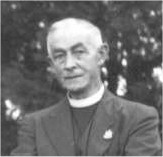|
The story that we relate here is absolutely true.
We have always considered it an ideal subject for a short film or television
program and of course given that the locations are completely unchanged and
located beside a still working steam railway means that a complete
re-enactment would be quite simple to arrange! If you are a program maker and would like more local detail please
contact the webmasters, contact details at the foot of the page.
The information that follows has been gleaned from
a variety of sources including in particular local newspaper cuttings for
the supply of which we thank the Worthing library, confirmed with other
details in "An illustrated History of the Lewes and East Grinstead Railway"
by Klaus Marx.
In World War II 1943 life was hard and Gunner
Ronald Knapp married Corporal Winifred Standing on Saturday 31st. July at
St. Giles Church, Horsted Keynes. Gunner Knapp was shortly going on an
overseas posting so he had been granted a short leave time for his wedding
and honeymoon. The couple remained married for just 4 hours.
As it was wartime the wedding breakfast was held
at the home of the Bride which was Nobles Farm on the parish boundary
between Horsted Keynes and Lindfield near what is now the Bluebell Railway.
The groom's parents lived in Haywards Heath and had to leave the reception
early to catch the last bus for home from the stop outside what is now
Holywell waterworks
but was then a very deserted area. The newly
married couple decided to walk with them to the bus stop, and it was this
decision that made the drama begin and their lives end.
It was of course dark on any wartime evening (no
street lighting and a blackout then of course) and with very heavy rain
visibility was poor. So having seen their new in-laws safely off onto the
bus for Haywards Heath at 20.20 the newlyweds decided to walk back to the reception
not by the path beside the potholed waterlogged farm track but along the less muddy railway
line
which in this weather was the easiest route from the bus stop back to Noble's
Farm.
Unfortunately this was the same time as the train
from Lewes to East Grinstead which would have been travelling "tender first"
i.e. with the engine travelling at the front of the train but backwards and at the relatively slow speed
of 25 miles an hour. The guard said that as they passed the bridge over the
road by Holywell he saw something dark lying in the track, so when the
train reached Horsted Keynes station three quarters of a mile or so away,
the guard got the driver to look at the front of the train, i.e. the rear of the engine, where he found
an old raincoat covered with blood.
A line ganger was called out from his home beside
the station and
while walking the line South from Horsted Keynes towards Holywell he made a grisly
discovery. Lying between the rails were the lifeless bodies of the newly
married couple, some distance further away was another mackintosh.
The ganger told the inquest which was held in
Haywards Heath that it appeared the couple had been walking with their backs
to the train with a single mackintosh over their heads. There had been a
very heavy squall at the time and the couple would probably have not heard a
thing.
At the inquest in Haywards Heath the Coroner Dr.
E. F. Hoare said that in his opinion the couple would have been killed or at
least rendered unconscious instantly. They were trespassing on the railway
track and no blame could be attached to any railway worker. In fact he said
that they performed in an exemplary manner.
 It was the same rector who married the couple the
Rev Stenton-Erdley who had the sad duty of burying them together in St.
Giles Churchyard a little over a week later. It was the same rector who married the couple the
Rev Stenton-Erdley who had the sad duty of burying them together in St.
Giles Churchyard a little over a week later.
They still lie there together to this day under a War Graves Commission
headstone, pictured below courtesy of Bill Price.
* For the avoidance of doubt this was obviously well before the Bluebell
took over the line.
|